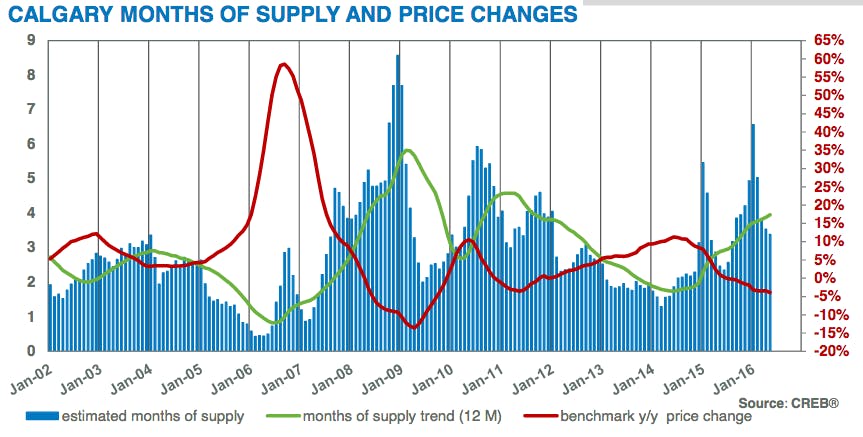market update
Team Penley McNaughton YYC Newsletter and Market Statistics



Click on the following link to view the full Team Penley McNaughton’s YYC Newsletter for May 2016
Calgary 2015 December Market Update
Housing market characterized by slow demand
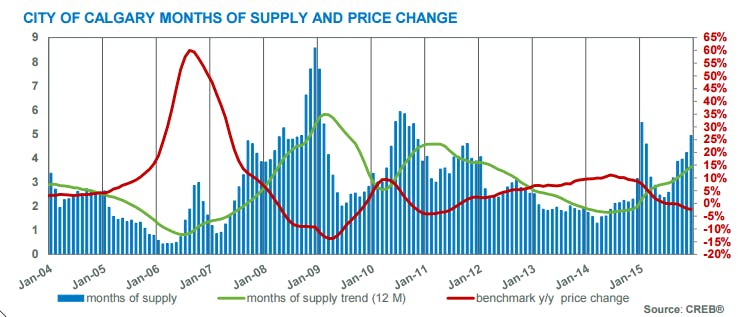 Elevated supply levels placed downward pressure on prices in December:
Elevated supply levels placed downward pressure on prices in December:
Calgary, Jan. 4, 2016 – With the focus shifting toward the holiday season, December sales activity slowed to 878 units in the city, 18 per cent below last year at this time and well below the five and 10-year averages.
As a result, the unadjusted benchmark price dipped to $448,800, a 0.42 per cent decline over the previous month and 2.33 year over year. CREB® chief economist Ann-Marie Lurie noted December followed a pattern established early on in 2015, which was characterized by slower housing demand.
“Economic uncertainty, followed by weak economic conditions and job losses, contributed to slowing housing demand throughout the year,” she said.
“That said, while aggregate prices trended down in 2015, it was not to the same extent as some had speculated. Supply levels were low moving into this cycle and thus provided some cushion to absorb the inventory gains.”
In December, monthly inventory levels declined, as expected, to 4,336 units. Yet they were still 28 per cent higher than the same time last year, and at the highest December level recorded since 2008. Inventory levels were notably up in both the apartment and attached sectors, which neared the highest December total on record.
“December showed that buyers in this market are continuing to be much more cautious as the impact of further oil price declines weighs on their confidence,” said CREB® president Corinne Lyall. “Some sellers, meanwhile, are concerned about what supply levels may look like next year and are not delaying their decisions.”
On an annual basis, sales activity declined by 24 per cent in the detached sector and 33 and 28 per cent in the apartment and attached segments, respectively. While months of supply in 2015 trended higher in all sectors, the apartment was the only one to average above four for the entire year.
Click here to view the full monthly stats package.
Housing prices to ease in second half, CREB® forecasts
Continued weakness in housing demand will limit downward pressure on supply levels and cause prices to ease in the second half of the year, CREB® said in its 2015 mid-year forecast. Despite this anticipated retraction, Calgary’s benchmark prices are only expected to decline by less than one per cent on an annual basis.
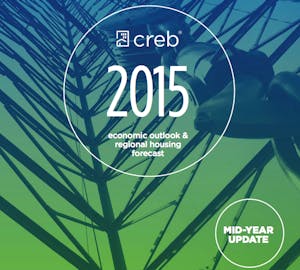
“Further job losses are expected in the second half of the year,” said CREB® chief economist Ann-Marie Lurie. “These employment changes, combined with overall weakness and slower than anticipated recovery of oil prices, are expected to keep housing demand relatively weak for the rest of 2015. However, with the initial shock of oil price declines having dissipated, the pullback in sales activity in the second quarter is not expected to be as dramatic as the first part of the year,” said Lurie.
Overall sales activity in Calgary is forecasted to total 19,798 in 2015, a 22 per cent decline relative to last year, but only six per cent lower than average activity over the past five years.
Dramatic swings in new listings during the first half of the year caused inventory levels to rise, but by June, they remained below previous highs. Over the second half of the year, inventory levels traditionally ease as we move toward the fall and winter markets. However, this year housing supply levels are expected to remain relatively elevated due to improved selection in the rental markets, completion of projects under construction, and an easing in the rate of decline in resale new listings.
While some price moderation is expected moving forward, it should be noted that it’s not going to be the double-digit decline that some have suggested. In part, this is related to the limited supply in the market moving into this next cycle. Also, the forecasted pullback in employment and migration is not going to be as severe as what occurred last time we recorded significant price declines. The City of Calgary residential benchmark price is expected to average $448,354 for 2015, a modest 0.20 per cent decline over the previous year.
“It’s a two sided coin when talking about pricing for buyers and sellers,” said CREB® president Corinne Lyall. “Some buyers have the expectation that they will get significant price reductions in this market, but that’s not always the case. In some areas, supply levels are more balanced with demand and that creates price stability. On the other hand, in most situations, it will be the sellers who need to adjust expectations, particularly if they have to compete with a large amount of comparable product in the neighbourhood.”
While slower demand is impacting all sectors of the market, the apartment sector is expected to record the largest pull-back in both sales and price growth in the second half. Challenges in this segment are linked to the rising supply in competing markets. There is more selection is the detached and attached segments, which makes it difficult to attract buyers. Sellers also faced added competition from new apartment units and increased selection in the rental market.
Meanwhile, activity in the detached segments will continue to vary based on price and location. Continued weakness in demand relative to supply levels, particularly in the higher price ranges, are expected to cause aggregate detached benchmark home prices to decline in the second half of this year. However, annual prices are expected to remain relatively unchanged compared to last year. Overall, detached sales are expected to total 12,105 units in 2015, a 19.8 per cent decline over last year.
“It’s important for active housing consumers to understand what type of comparable property is available by product type, community and price range,” said Lyall. “While some degree of competition exists in every market condition, most sellers in the current environment will need to take extra care in setting realistic expectations to attract a good crop of potential buyers. This kind of smart pricing may encourage buyers who are sitting on the sidelines to consider entering the market if they are in a position to do so.”
As with any market forecast, there are several factors that could influence the outlook. On the upside, if there is no further deterioration in the economic climate, it’s possible that the pullback in housing demand could be less severe. In this scenario, potential buyers who are in the market may decide to take advantage of higher supply levels and overlook short-term risks in favour of the positive long-term outlook. This possibility could keep market conditions relatively balanced in the second half and prevent any further price declines.
“Ultimately, what happens to prices will depend on supply levels and how much they go up or down against demand,” said Lurie. “The duration of this economic downturn and the resulting job loss will determine which direction supply will go in the months ahead.”
To download a PDF of the full CREB® mid-year forecast update, click here
Calgary luxury home sales on record pace
Every month this year has set a new peak for MLS transactions
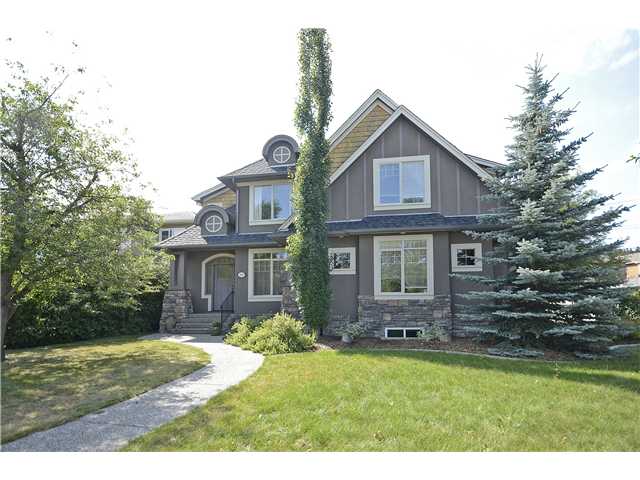 The appetite for luxury homes in Calgary continues to be very strong as another MLS sales record was established in August.
The appetite for luxury homes in Calgary continues to be very strong as another MLS sales record was established in August.
According to the Calgary Real Estate Board, there were 69 properties that sold for $1-million or more during the month, eclipsing the previous monthly high of 64 set last year.
Each month this year has established a record for luxury home sales.
Year-to-date, there have been 611 luxury home sales until the end of August compared with 522 for the same period last year. The all-time peak for annual sales at the $1-million plus level was in 2013 with 726 MLS transactions.
“Bolstered by the city’s thriving economy, the strength of its oil and gas sectors, low unemployment rates, high average net incomes and strong net migration, the market for high-end homes continued its upward trajectory with single-family home sales up 19 per cent and attached home sales up 21 per cent year-over-year,” said Sotheby’s International Realty Canada’s Top-Tier Real Estate Report for the first half of the year, which was released on Thursday.
“Due to limited inventory in Calgary’s condo market, sales decreased 25 per cent compared to the same time last year. With a number of new high-end condo projects recently announced in Calgary’s downtown core, it is expected that the volume of luxury condo sales above $1 million will increase in the second half of 2014.”
Ross McCredie, president and chief executive of Sotheby’s International Realty Canada, said the Calgary housing market is still relatively inexpensive for many people who have moved to the city from other parts of Canada.
“There’s a ton of different factors (to the luxury home boom) but overall there’s a ton of confidence,” he said.
“Low interest rates, a lot of confidence specifically in Calgary where you have a lot of investment, very, very low unemployment and you have huge demand for jobs . . . Overall we don’t see anything that’s going to change in the horizon right now for us.”
The Sotheby’s report said low inventory in the beginning of the year drove bidding wars and price increases in a market that favoured sellers.
“Over the summer months, new inventory over $1 million emerged to meet strong consumer demand, particularly in the condominium market, a trend which is expected to continue into the fall,” it said. “At the same time, Calgary’s robust economy is expected to sustain demand for luxury real estate, and notable growth is expected in the $4 million single-family home market throughout the fall and into 2015 as this category has already outpaced 2013 sales numbers.”
By Mario Toneguzzi, Calgary Herald
CALGARY REGIONAL HOUSING MARKET STATISTICS – August 2014
Condominium sales set a new record for August activity
Sales activity improves for condominium product, while declining in the single-family sector
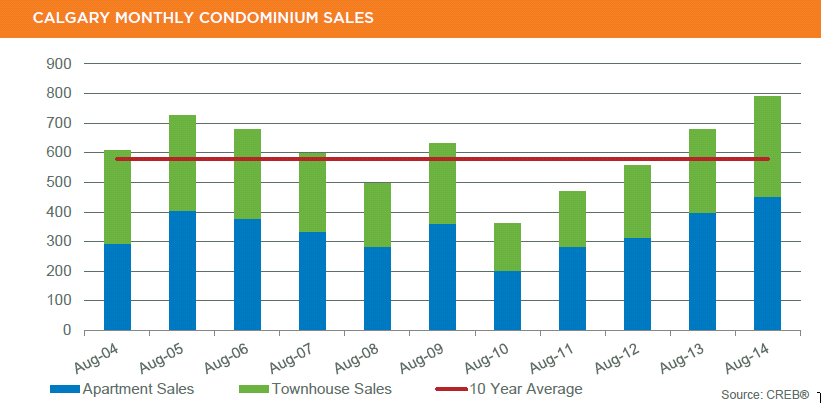
Strong gains in Calgary’s condominium apartment and townhouse sectors sparked a 3.4 per cent year-over-year growth in residential resale housing sales activity for August. A total of 2,267 units exchanged hands in the city during the month, compared to 2,192 during the same period in 2013.
The condominium apartment and townhouse sectors saw the biggest gains, increasing by nearly 14 and 20 per cent, respectively, for total monthly sales of 790 units. “The record pace of August sales in the condominium sector is related to the relative affordability of this product combined with a tight rental market and low lending rates,” said CREB® chief economist Ann-Marie Lurie, noting most of the activity continues to take place in lower price ranges.
“More than 76 per cent of condominium new listings are priced below $400,000 and represent more than 68 per cent of the total inventory within city limits.” So far this year, condominium apartment and townhouse sales have totaled a respective 3,388 and 2,685 units. This represents a combined increase of nearly 20 per cent.
“Over the past three months apartment-style new listings have increased by more than 40 per cent year over year, pushing up overall inventory levels and moving this market toward balanced territory despite the strong sales growth,” said Lurie. Meanwhile, year-over-year single-family sales declined by 2.4 per cent in August to 1,477 units, partly due to limited availability in lower price ranges. Despite the pullback, activity in the sector remains stronger than long-term averages.
“The decline in single-family sales is mostly due to the shrinking supply in the under-$400,000 sector,” said CREB® president Bill Kirk. “Overall, sales activity has improved compared to last year for product priced over $400,000.”
The good news for buyers is added choice. New listings in August improved by 13.6 per cent compared to last year, causing inventories to rise by nearly 18 per cent. Increased inventory levels also moved the single-family market toward more balanced conditions, helping minimize further monthly price gains.
The single-family unadjusted benchmark price totaled $512,300 in August, similar to July, but still 10.24 per cent above $464,700 posted a year ago. “Following a prolonged period of Calgary being a sellers’ market, a move toward more balanced conditions is welcome news,” said Kirk.
“This will help support a more stable city housing market in terms of price gains.” The average, median and benchmark prices for condominium apartments in August were a respective $332,006, $287,500, and $298,200. “While both average and median prices in this sector have recorded further monthly gains, the benchmark indicates prices are similar to levels recorded in the previous month,” said Lurie.
“The composition of apartment sales shifted toward the higher-end segment this month compared to last month, resulting in higher monthly gains. The benchmark price reflects price changes for similar properties, less subject to the variability in composition.”
Condominium townhouses remain the tightest of the three sectors in Calgary, resulting in further monthly price gains and reaching an August benchmark price of $328,300. While prices are shy of previous highs, they increased by 0.4 per cent over the previous month and nearly 10 per cent above levels recorded in August 2013.
Click Here to view the full .pdf of the CALGARY REGIONAL HOUSING MARKET STATISTICS – August 2014
Calgary resale housing market experiences highest annual price growth
10.48% hike from a year ago
Calgary continues to far outstrip the rest of the country when it comes to annual price gains in the resale housing market.
The MLS Home Price Index, released Friday by the Canadian Real Estate Association, said prices in the Calgary area in July were up by a whopping 10.48 per cent compared with a year ago. Meanwhile, the national aggregate, comprising 11 centres, saw a year-over-year hike of 5.33 per cent as sales rose to their highest level since March 2010.
The closest centre to Calgary’s annual spike was Toronto which recorded a jump of 7.88 per cent.
“As market conditions move toward more balanced conditions, it is causing prices to level off. However, due to strong gains in the first half of the year, even with prices levelling off, year-over-year gains remain at higher levels,” said Ann-Marie Lurie, the Calgary Real Estate Board’s chief economist.
Over the past three years, Calgary also has the highest rate of price growth at 25.01 per cent compared with 12.52 per cent nationally. And over five years, Calgary’s 28.89 per cent spike is second only to Toronto’s 40.48 per cent increase while it is 26.89 per cent across the country.
Don Campbell, senior analyst with the Real Estate Investment Network, said it takes 18 months for immigration and population growth to begin to affect the resale and new housing markets. Also, a demand/supply imbalance has contributed to higher prices.
He said the housing market is being affected by tightness in rental vacancy and lack of new supply.
“So the record population growth we witnessed last year is now being felt,” he said.
“Combine this with a general decrease in available single-family home building lots and this is keeping the inventory tighter than normal, thus adding upward value pressure on resale market.”
The number of homes sold nationally through the MLS systems of Canadian real estate boards and associations rose to 48,000 in July – a 7.2 per cent hike from a year ago.
Calgary area sales of 3,177 were 6.8 per cent higher and Alberta sales of 7,194 were up 5.0 per cent.
“Low mortgage interest rates continue to bolster home sales activity,” said Gregory Klump, CREA’s chief economist, in a news release. “With the Bank of Canada widely expected to hold interest rates steady until next year, home purchase financing will remain attractive over the second half 2014 and continue to support economic growth while waiting for Canadian exports and investment to improve.”
In terms of average MLS sale prices, Calgary saw a rise of 5.2 per cent year-over-year to $460,790 while the increase was 4.2 per cent in Alberta to $395,552 and 5.0 per cent across the country to $401,585.
Leslie Preston, economist with TD Economics, said low interest rates are continuing to fuel the Canadian housing market into the summer.
“The renewed momentum in Canada’s housing market in recent months represents both a bounce back from weather-related weakness over the winter months and a response to lower mortgage rates,” explained Preston. “Potential buyers who may have sat on the sidelines last year as interest rates rose, are being enticed back to the market by lower interest rates. Meanwhile, a strengthening in economic growth continues to support the fundamental demand in the housing market.
“However, existing home prices . . . are on track to outstrip income growth for a second straight year in 2014, which adds to concerns about an already-overpriced market. Affordability, even at low interest rates, has become an obstacle in many markets. This contributes to our view that the Canadian housing market will cool later this year and into 2015 as interest rates are likely to nudge higher. Another factor which is expected to weigh on prices is the supply growth in the pipeline due to the record number of new homes that are under construction in many markets.”
By Mario Toneguzzi, Calgary Herald
Calgary region housing starts to increase 24% in 2014
But decline almost 8% in 2015
Housing starts in the region are forecast to rise by 24 per cent in 2014 from last year but then dip by 7.7 per cent in 2015, according to a new report released Wednesday by Canada Mortgage and Housing Corp.
The agency’s housing outlook says starts in the Calgary census metropolitan area will increase from 12,584 in 2013 to 15,600 this year but then fall to 14,400 next year.
“The rise in total housing starts this year is due to a combination of increased demand and a decline in supply,” said Richard Cho, senior market analyst in Calgary for the CMHC. “Employment growth in Calgary continues to post impressive gains with the majority in full-time positions. Low mortgage rates have also helped people purchase a home and migration has been elevated in the last couple of years. This has supported the demand for housing. Selection in the resale market has been low which has led to some prospective buyers to look to the new home market. Not only are active listings low but new home inventories are down, which will also contribute to the rise in construction this year.
“In 2015 total housing starts are forecast to decline but still reach its second highest level since 2006. Job creation in Calgary is forecast to moderate from the elevated pace in 2014 and net migration, although remaining positive, will decline as economic conditions improve in other areas of the country. We are also anticipating that buyers will have more homes to choose from as average monthly active listings are expected to be higher. The number of new homes under construction has increased and may put more upward pressure on inventories when completed. This will impact the opportunity to increase new construction in 2015.”
For Alberta, starts are forecast to increase by 7.2 per cent this year to 38,600 units but decline by 4.7 per cent next year to 36,800 units.
The agency is expecting MLS sales in the Calgary region to improve by 9.8 per cent this year to 32,900 units and by another 2.4 per cent in 2015 to 33,700 transactions. CMHC says the average MLS sale price will rise by 5.0 per cent in 2014 to $459,000 and by 2.8 per cent in 2015 to $472,000.
“The economy in Calgary is anticipated to continue creating jobs, attracting migrants and supporting income growth,” said Cho. “However, the rate of increase in some of these key housing demand factors will moderate throughout the forecast period. This will also be reflected in the resale market.
“Home prices in Calgary have experienced more upward pressure from the low supply of active listings on the market compared to previous years. Buyers have been competing for a lower selection of homes, resulting in multiple offers on many homes and shortening the average days-on-market. The MLS price is forecast to rise five per cent in 2014. As we move towards the end of 2014 and into 2015, the supply of resale homes is anticipated to move higher. New listings in Calgary have started to pick up and are forecast to rise this year and next. This will help ease some of the upward pressure on prices in 2015 resulting in a 2.8 per cent increase.”
For Alberta, MLS sales are forecast to be 5.8 per cent higher this year to 69,900 followed by a 2.9 per cent gain next year to 71,900.
The average sale price in the province is expected to increase by 4.2 per cent this year to $396,800 and by 2.6 per cent next year to $407,000.
CALGARY REGIONAL HOUSING MARKET STATISTICS – July 2014
Growth in new listings outpace sales growth in July, supporting double-digit inventory gains
Calgary, Aug. 1, 2014 – Residential sales this month totaled 2,336 units, a record level for July activity. However, year-over-year sales growth slowed to 3.18 per cent.
“While July’s sales growth seems like a dramatic departure from the double-digit gains recorded in the first half of this year, it is in comparison to exceptionally strong sales during the same period last year,” said CREB® chief economist Ann-Marie Lurie, noting July sales this year are nearly 19 per cent above long-term averages for the month.
New listings in July totaled 3,219 units, an 18 per cent increase over the previous year. The rise outpaced sales growth during the month, pushing inventory to 4,659 units, nearly 14 per cent higher than July 2013 levels.
“More selection is welcome news for many potential purchasers. However, improving supply levels have only come after nearly three consecutive years of declines,” said CREB® president Bill Kirk. “Along with improving inventories, other indicators support the notion that market conditions are moving toward more sustainable levels.”
Single-family unadjusted benchmark prices totaled $511,600 in July, just above May figures, but 10.8 per cent higher than $461,600 in July 2013.
“Following two years of annual increases and several months of monthly gains that exceeded one per cent, unadjusted benchmark prices appear to be leveling off,” said Lurie. “This fits with our expectations as the market moves into more balanced territory.”
Single-family sales totaled 1,553 units in July, a 1.3 per cent decline compared to the same period in 2013 and a 8.3 per cent increase year-to-date.
While overall single-family sales remain higher than long-term trends for this month, the year-over-year monthly decline reflects fewer sales and listings in properties priced under $400,000.
“With declining choices in the lower-priced single-family market sector, consumers are considering both condominium apartment and townhouse segments,” said Kirk.
Year-to-date condominium apartment and townhouse sales increased by 21 and 19 per cent, respectively. New listing growth far outpaced sales growth, particularly in the apartment sector, thus boosting inventory levels.
For buyers, more choice has helped ease some of the upward pressure on benchmark prices. Unadjusted prices in both apartment and townhouse-style condominiums were similar to levels recorded the previous month. Despite slower monthly gains, year-over-year price growth grew by 11 per cent in the condominium sector. Benchmark prices for apartment and townhouse-style condominiums in July totaled $298,100 and $327,000, respectively.
“Calgary’s housing market continues to demonstrate exceptional levels of sales, and strong year-over-year price gains,” said Lurie. “This is a reflection of the economic factors supporting this market, including gains in net migration, employment, wage growth and favourable lending rates.”
Click on the image below or the following link for the full .pdf report: Calgary Regional Housing Statistics for July 2014
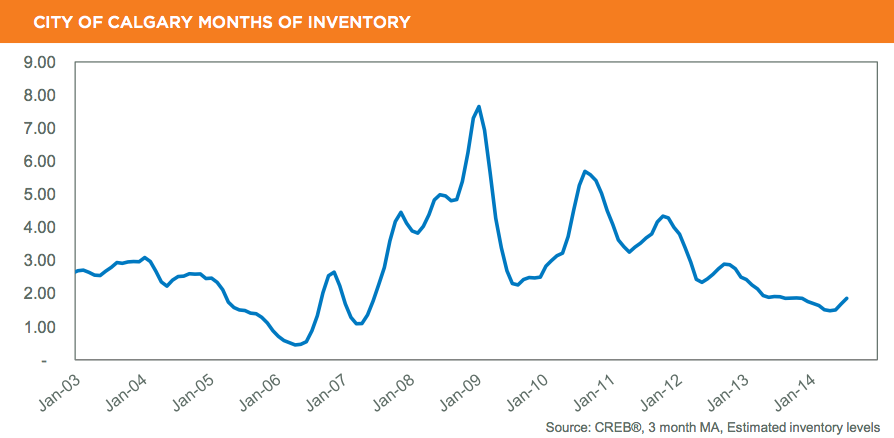
CALGARY REGIONAL HOUSING MARKET STATISTICS for June 2014
Housing supply improves in June
Condominium apartment benchmark price surpasses previous highs
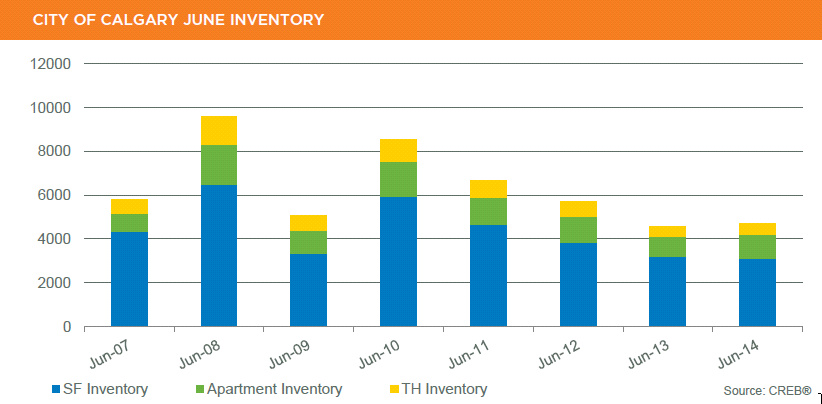 click on the link or image above for the full CALGARY REGIONAL HOUSING MARKET STATISTICS for June 2014
click on the link or image above for the full CALGARY REGIONAL HOUSING MARKET STATISTICS for June 2014
Residential sales and listings in Calgary increased by double-digit rates in June compared to the same time last year. This increase is partly due to the floods impacting housing activity throughout the second half of June 2013.
“Last June was not a normal month, so it’s difficult to compare the two,” said CREB® president Bill Kirk. “The historic floods of 2013 forced residents and business owners from their homes and places of work. It’s not surprising that many Calgarians were not focused on purchasing or listing their home at that time.”
Despite the unusual circumstances of last year, the housing market continues to demonstrate strong demand. Residential sales totaled 2,670 units this June, which was 18 per cent above the 10-year average. Total sales for the first half of 2014 increased to 13,929 from 12,257 in 2013.
New listings totaled 3,814 units in June, representing the first time since June 2010 that it outpaced the long-term average. The monthly influx of new listings also helped ease some of the tightness in the market by improving inventory levels, which totaled 4,726 units compared to 4,584 in June 2013.
“Economic conditions continue to support housing demand growth. However, improving supply should help push our market toward more balanced conditions,” said CREB® chief economist Ann-Marie Lurie. “Over time, this will cause price growth to ease from its current levels.”
Single-family unadjusted benchmark prices totaled $509,700 in June, a one per cent increase over the previous month, and a 10.9 per cent increase over June 2013.
Single-family sales for June totaled 1,769 units, which outpaced the 10-year average by 10 per cent. The rise in sales activity was largely due to improved new listings. While this helped ease some of the tightness in this market, supply levels continue to fall in this sector.
The boost in single-family new listings for June was largely due to an increase in units listed at more than $500,000 – rising to 1,359 units in June from 954 the year prior.
“With less resale single-family product available in the lower price ranges citywide, this market continues to be fairly competitive,” said Kirk. “However, for consumers looking in the higher price ranges, there is often more choice.”
Condominium apartment sales for the first half of 2014, totaled 2,494 units, compared with 2,027 during the same period a year prior. While new listings growth kept pace with sales activity during the first part of the year, it has exceeded sales growth over the past two months, pushing up inventory levels and moving this market into more balanced conditions.
Apartment-style benchmark prices totaled $299,700 in June, a new high in the condominium apartment sector and 13.5 per cent increase over the previous year. Meanwhile, the benchmark price for townhouse-style units reached $326,000, still shy of previous records.
“As citywide condominium apartment prices have finally recovered from 2007 highs, we would expect this will continue to encourage some listings growth,” said Lurie. “However, as this market has moved into more balanced conditions, and if inventories continue to rise, price growth should ease throughout the remainder of the year.”






